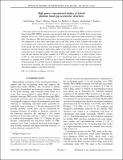| dc.contributor.author | Zhang, Jiexi | |
| dc.contributor.author | Munroe, Brian James | |
| dc.contributor.author | Xu, Haoran | |
| dc.contributor.author | Shapiro, Michael | |
| dc.contributor.author | Temkin, Richard J | |
| dc.date.accessioned | 2018-10-31T18:57:06Z | |
| dc.date.available | 2018-10-31T18:57:06Z | |
| dc.date.issued | 2016-08 | |
| dc.date.submitted | 2016-02 | |
| dc.identifier.issn | 2469-9888 | |
| dc.identifier.issn | 1098-4402 | |
| dc.identifier.uri | http://hdl.handle.net/1721.1/118827 | |
| dc.description.abstract | This paper reports the first high power tests of hybrid photonic band gap (PBG) accelerator structures. Three hybrid PBG (HPBG) structures were designed, built and tested at 17.14 GHz. Each structure had a triangular lattice array with 60 inner sapphire rods and 24 outer copper rods sandwiched between copper disks. The dielectric PBG band gap map allows the unique feature of overmoded operation in a TM₀₂ mode, with suppression of both lower order modes, such as the TM₁₁ mode, as well as higher order modes. The use of sapphire rods, which have negligible dielectric loss, required inclusion of the dielectric birefringence in the design. The three structures were designed to sequentially reduce the peak surface electric field. Simulations showed relatively high surface fields at the triple point as well as in any gaps between components in the clamped assembly. The third structure used sapphire rods with small pin extensions at each end and obtained the highest gradient of 19 MV/m, corresponding to a surface electric field of 78 MV/m, with a breakdown probability of 5 × 10⁻¹ per pulse per meter for a 100-ns input power pulse. Operation at a gradient above 20 MV/m led to runaway breakdowns with extensive light emission and eventual damage. For all three structures, multipactor light emission was observed at gradients well below the breakdown threshold. This research indicated that multipactor triggered at the triple point limited the operational gradient of the hybrid structure. | en_US |
| dc.description.sponsorship | United States. Department of Energy (Grant DE-SC0010075) | en_US |
| dc.publisher | American Physical Society (APS) | en_US |
| dc.relation.isversionof | http://dx.doi.org/10.1103/PHYSREVACCELBEAMS.19.081304 | en_US |
| dc.rights | Creative Commons Attribution 3.0 Unported license | en_US |
| dc.rights.uri | http://creativecommons.org/licenses/by/3.0/ | en_US |
| dc.source | APS | en_US |
| dc.title | High power experimental studies of hybrid photonic band gap accelerator structures | en_US |
| dc.type | Article | en_US |
| dc.identifier.citation | Zhang, JieXi et al. “High Power Experimental Studies of Hybrid Photonic Band Gap Accelerator Structures.” Physical Review Accelerators and Beams 19, 8 (August 2016): 081304 © 2016 American Physical Society | en_US |
| dc.contributor.department | Massachusetts Institute of Technology. Department of Physics | en_US |
| dc.contributor.department | Massachusetts Institute of Technology. Plasma Science and Fusion Center | en_US |
| dc.contributor.mitauthor | Zhang, Jiexi | |
| dc.contributor.mitauthor | Munroe, Brian James | |
| dc.contributor.mitauthor | Xu, Haoran | |
| dc.contributor.mitauthor | Shapiro, Michael | |
| dc.contributor.mitauthor | Temkin, Richard J | |
| dc.relation.journal | Physical Review Accelerators and Beams | en_US |
| dc.eprint.version | Final published version | en_US |
| dc.type.uri | http://purl.org/eprint/type/JournalArticle | en_US |
| eprint.status | http://purl.org/eprint/status/PeerReviewed | en_US |
| dc.date.updated | 2018-10-11T17:53:39Z | |
| dspace.orderedauthors | Zhang, JieXi; Munroe, Brian J.; Xu, Haoran; Shapiro, Michael A.; Temkin, Richard J. | en_US |
| dspace.embargo.terms | N | en_US |
| dc.identifier.orcid | https://orcid.org/0000-0003-1284-3892 | |
| dc.identifier.orcid | https://orcid.org/0000-0002-1915-8647 | |
| dc.identifier.orcid | https://orcid.org/0000-0001-9813-0177 | |
| mit.license | PUBLISHER_CC | en_US |
